Today, I had a date with history. Went back around 100 years or more in time. My time machine? A bright red bus full of history aficionados, ranging from age 6 to age 78.
At the other end, they were waiting for us. An armed revolutionary, a Parliamentarian par excellence, a political poet, a fiery freedom fighter, an education reformist family, a Keynesian saint and of course, Bapu. And they were not alone. With them, we met their families, their close friends, their role models, their contemporaries, their favourite authors. Most importantly, we met with their thoughts. Their thoughts, their passion, their mistakes, their vision. We met with our future in the past.
Virasat Pune, the heritage wing of Janwani (an NGO) had arranged the “Freedom Trail.” It was a day tour to some destinations in Pune city, which were deeply involved in the Indian freedom struggle. And as usual, they had come up with a fairly unusual program! The tour promised visits to these destinations, short documentaries on the freedom fighters, a walk around museums accompanied by well-informed guides.
Econ mom really likes history, though, I would be extremely reluctant to claim that I’ve been able to pass on any of my passion across to my Lil One. In fact, when I first informed my family that I plan to go, the immediate reactions were very rude, rather expected and completely silly. “Oh God! Now she is going to go and get inspired by freedom fighters! Honey, don’t you think you are way too independent in any case?” That was Hubby, who believes that he represents the moderate view in our family decisions. Guess who the extremist is. Sigh.
“Wow, mom! A full day freedom trail!” I was just beginning to get into my filmy “Bhagwan ke ghar mein der hain, andher nahi” mode and wipe tears of joy of having succeeded in my motherhood duties of creating a socially sensitized child, when “That means I get to go and play with Swapnil the full day. Freedom, mom, freedom. Freedom is very important.” Oh, the traumas of motherhood. Sigh, sigh and more sighs.
Well, so family bade me a goodbye rather cheerfully and I entered the big red bus that was to take us back in time. There were some 30 others like me. A young couple had brought along their 6 year old, there was another mom- teen daughter duo, a couple of other ladies who, like me, seemed to have come to the tour by themselves, two friends in their twenties (very IT, I thought), two elderly couples, some senior citizens.
And the star factor was that we had RJ Sangram from 93.5 Red FM with us! Bajaate raho! Hee hee, I had some wicked thoughts of how jealous Lil One is going to be when he hears about this. That’ll shut them up, I thought, optimistic as always.
The bus was decorated with little flags and looked very pleasant and exactly like a “Freedom Trail Bus”. Our guides Ashwini, Suchitra and Kshitija, explained the format of the tour and we were ready to go.
Chapekar Brothers
Our first halt took us back 118 years in history. 1897, Pune. Plague had hit Pune and by 1897, had assumed worrying proportions. W.C. Rand, the Plague Commissioner of Pune, was handling it by literally forcing his way into people’s houses, identifying who was ill and forcefully ejecting whoever he thought were carrying symptoms of the disease. Man, woman, child. No one was spared.
This oppressive way of dealing with ill people created a hue and cry in India. Lokmanya Bal Gangadhar Tilak, who by then, way already fed up with the lukewarm way in which the Congress was handling the freedom struggle, wrote some fiery articles against the British in Kesari, the Marathi newspaper of which he was Editor. Inspired by these, the Chapekar Brothers shot down Rand and Ayerst, the Plague Commissioners of Pune. The brothers were later tried and found guilty of murders and were hanged. A memorial has been built at the Ganesh Khind where the shooting happened as a tribute to the bravery of the Chapekar brothers. There is also a black tombstone representing W. C. Rand.
Gopal Krishna Gokhale
The same event had very different repercussions on yet another reformer, Gopal Krishna Gokhale, an economist of repute and a Parlimentarian par excellence. Our next stop was at my alma mater, the Gokhale Institute of Politics and Economics. Gopal Krishna Gokhale, always an academically gifted person, was initially very taken by Tilak’s extremist thoughts. But he was soon drawn to the more reformist thoughts given by Justice Mahadeo Govind Ranade. The debate between Ranade and Tilak was extremely interesting.
Tilak used to believe that only after political independence can one begin to create social systems that we desire. Swaraj first. Ranade, while never disagreeing with the power of Swaraj, wanted to create social reform that would empower people so that they would be able to handle the freedom. So we will gain Swaraj. But if a majority of people believe in caste distinctions and gender inequality, will we ever able to make the most of our independence?
It’s almost Amartya Sen-Jagdish Bhagwati-esque in its style, I thought. What should come first, growth or distribution? Similarly, the Ranade-Tilak debate was what comes first? Social reform or political independence?
When Gokhale heard about the plague epidemic, he was in England and wrote extensively in English newspapers about the way in which the British were handling the crisis badly. The British asked for written proof and to Gokhale’s great consternation, no one in India was willing to come ahead to give a written account. Gokhale faced a lot of criticism both in India and abroad and had to finally give a written apology for unverified remarks to the British.
This single incidence created the Gokhale of later times. A Gokhale, who decided that no statement can be made without data. A Gokhale, who started creating impressive documentations which would help to establish the “Drain Theory” of how the British were economically draining India. It was Gokhale who proved that the British run fiscal surpluses in India, when the economic system here faces stagnation. After studying all accounts, he established that the fiscal surplus is nearly Rs.7 crores! He made passionate claims to the British to either spend more in India for critical infrastructure development or at least reduce the taxes. His findings showed that the biggest tax impact is on salt.
It was of course Mahatma Gandhi whose famous Salt Satyagraha took the country by storm much later. But the economic ideology and indeed data for the Dandi March comes from this amazing economist and Gandhi’s political Guru Gopal Krishna Gokhale. This is the genesis of moderate thought in India. Justice Ranade, Gopal Krishna Gokhale and then the political successor, Mahatma Gandhi.
Veer Savarkar
Whilst the moderates were making serious inroads into understanding ideal administrative and social systems, revolutionaries in Pune were creating a furore against the British Raj in their own way. Amongst these was a young political poet, Vinayak Damodar Savarkar, who was then a student at Fergusson College.
Our bus took us to Fergusson College, where students of the History Club were waiting to take us around their college and tell us about its history.
We visited Savarkar’s room, which, for me, was a highly emotional moment. It’s here that he must have penned those superb lines, I was thinking, trying to visualize a young Savarkar, writing in that room.
Savarkar initiated the event wherein British-made clothes were burnt on Karve Road. So furious was Rangler Paranjpe, the Principal of Fergusson College, that he rusticated Savarkar from the college. Tilak spared no time in writing an aggressive letter to Paranjpe, supporting Savarkar in his actions.
There was a light moment in the highly charged atmosphere at the Reading Hall. We were being told by the students how a British Officer Hotson was shot by an Indian revolutionary Gogate in the Reading Hall. However, Hotson was only wounded in the attack and did not die. Suddenly, a student not connected to the History Club chose to say “And they actually became really good friends after some time.” Such bromantic interpretations! I tried to press down my laughter, seeing the horrified faces of the budding historians and had a creative moment to myself, thinking of what Savarkar would have thought of this particularly crazy brand of humor.
Lokmanya Bal Gangadhar Tilak
As you must have sensed, Tilak’s shadow looms very large over the Independence struggle in India in general and the movement in Pune in particular. We next simply had to go to Kesari Wada, where we got to see and touch the printing press that had inked those fiery words and thoughts of this aggressive freedom fighter, Lokmanya Bal Gangadhar Tilak.
The museum at Kesari Wada has life-sized statues of Tilak at his desk and at Mandalay. It also is the proud host to the first Indian national flag that was created by Madam Cama. To see Tilak at his desk, writing incessantly for creating a free country for us, was a very touching moment for me. In fact, through the day, there were a lot of moments when my eyes were suspiciously damp, thinking about how many people had to give up their personal lives, go to prison, undergo humiliation and torture, so that I could enjoy my freedom. A thank you does not even begin to express my gratitude.
Mahatma Jyotiba Phule and Savitribai Phule
We then went to the place where the reform very close to my heart happened. We went to Phule Wada, where Jyotiba Phule lived with his wife Savitribai Phule and brought about a huge educational reform by starting a school for girls. When Savitribai used to go to the school, people used to spit on her, throw cow dung at her.
I was staring at the picture depicting all this humiliation she suffered and a part of me was re-running an image of me, in my swanky car, driving to college, living my life with political and economic independence, reading books by the dozens, arguing with male students and colleagues, voting after intense debates and discussions and partaking in every walk of life equally, as any man would. It was such a humbling moment to see Savitribai’s picture. You would have been proud to see today’s India, I told her. I owe my thoughts and my life to people like you and Maharshi Karve, who fought the society to get education for girls. Thank you.
Mahatma Gandhi
Where else could we head for the finale but to Aga Khan Palace, where Mahatma Gandhi was under house arrest for 21 months. It is here that Mahadev Desai, his secretary and Kasturba Gandhi, his wife, died.
The third Aga Khan was a saint Imam and at the age of 12, sanctioned a huge amount of money to create the palace, so that the poor labourers around the area would get jobs and food in a drought affected Maharashtra. A Keynesian saint! Our guide Neelam Ma’m is a Gandhi follower and was quick to point out that every visitor always feels refreshed on visiting the palace because it was firstly built with very good intentions by a person who was a saint. Second, it housed the Mahatma. It was here that Gandhi attempted to teach Kasturba to read and write, where Meera ben and Kasturba used to play carom, where Sarojini Naidu used to sing songs and bhajans when the confines became too overwhelming.
We saw a film on the Indian Independence at the palace. And after having been through the various memories and mementos of Bapu that the palace enshrines, we had a last halt at Yerwada Jail, where the Poona Pact was signed between Mahatma Gandhi and Dr. Babasaheb Ambedkar.
We signed off with Vande Mataram right in front of the prison. Kudos to Virasat and our coordinators for having come up with the idea and arranged the trail so beautifully! As we sat in the bus to head back home, the mood in the time machine was definitely sombre and reflective and yet, very positive.
Econ Mom had her brush with history today. A day that reminded me forcefully of my roots. A day when the past became the cause of the celebrations in the present. A day when I once again, felt proud to be an Indian.
Epilogue:
On coming home, Hubby asked me suspiciously if I am planning an armed revolt at home. Lil One had donned a forced, bored expression when I animatedly put him through all the stories. Only at one place did he seem thrilled. That is when I said “I went to the Yerwada Jail.” Sigh.



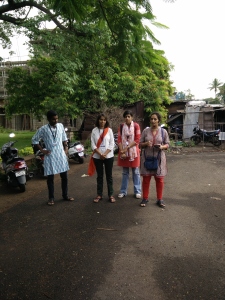
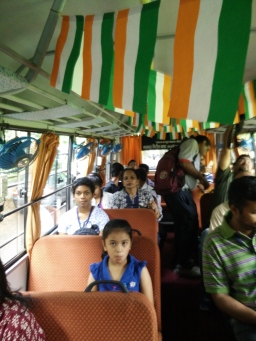
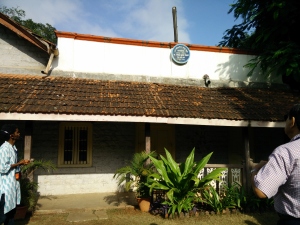
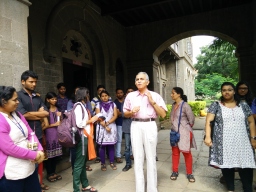
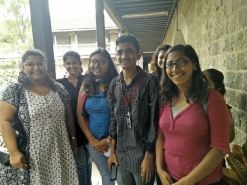
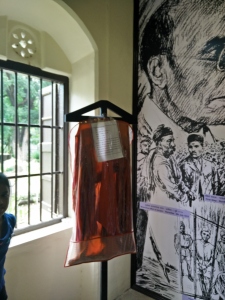
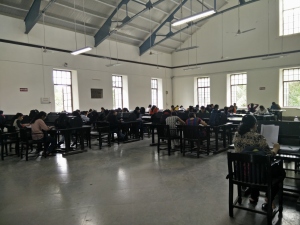
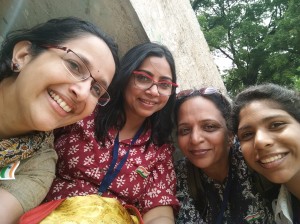
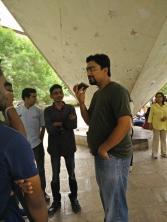
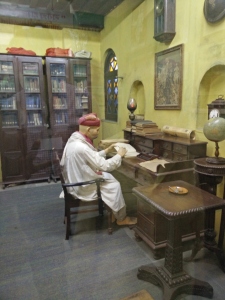
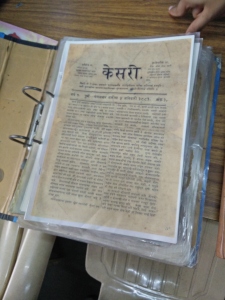

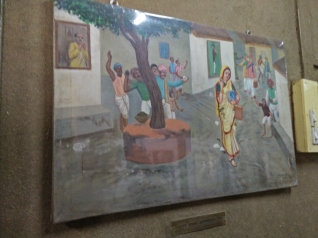
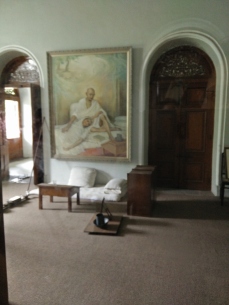
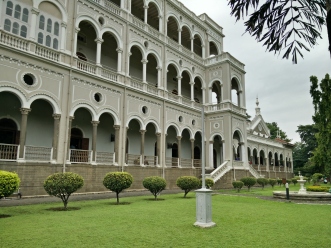
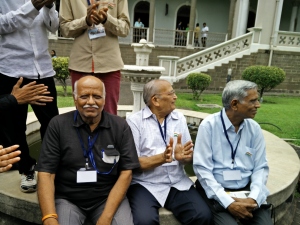
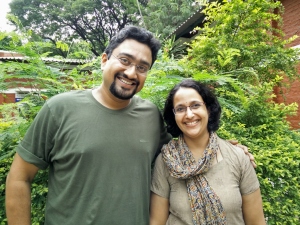
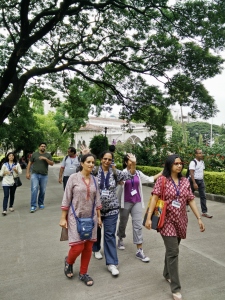
Mam your posts are a treat to read . Thank You for keeping on enlightening us
Sent from my iPhone
>
LikeLike
You are always welcome, Rajat. One of the biggest pleasures in writing a blog is the connect it gives me to all of you 😊
LikeLike
Very nice blog ma’am. Especially, the Bhagwati-Sen and Keynesian references were clever. Though a small technical mistake: it is Poona Pact, and not Pune Pact. 🙂
LikeLiked by 1 person
Oops 😊 will change it! Thanks for pointing that out ☺
LikeLike
Hi Manasi,
Thanks for this post. Different and enlightening. Does this happen in Pune regularly? WIll surely like to take the ride someday.All our Indian cities should have these really meaningful excursions on the weekends and help us save some time-waste. 🙂
There is little doubt that we hardly understand the challenges faced by some of these extraordinary people to create such a vast difference to humanity. I mean one is really humbled to read/follow history especially around India.
I heard two political science/history scholars last week on this idea of freedom, democracy and nations. How the western idea of nation could never really apply to India given the diversity. How likes of Gandhi and Nehru used this idea of freedom to unite the vast region and make it a nation. All these terms like nation, state, country etc have different meanings historically and we just dub them as one.
There is little doubt that Sen-Bhagwati debates have all been done in the past by different players under different topics. I mean these questions have been there for ages.
Even the idea of Keynes was pretty common sensical. Keynes never studied economics formally by the way which made him spot this before others. I mean what do you expect any politician to do in a crisis? Just sit and watch the decline? For instance, the grand Umaid Bhavan in Jodhpur was perhaps nothing but Keynesian in scope. I wrote about it here https://mostlyeconomics.wordpress.com/2012/09/07/keynes-in-jodhpur-in-1929-picked-from-kbc-6/
The problem has been to justify everything with govt under the Keynes name and extending the scope much beyond. It is usually the disciples of schools who create problems with the thought.
Anyways, no more economics. Let it just be political history ..
LikeLike
Hi Amol!
Thank you for visiting. Well, Virasat comes out with programs quite regularly and being a nature n heritage enthusiast, I find the intervention amazing 😊Do plan a visit.. It’s great fun!
I loved your blogs on the Jaipur Keynesian palace and the connection to KBC 😀 Superb!
Had the fever been still on, I’d have suggested we do a quick collaboration on it 😀 Keep the blogs coming… You are really doing a great job!
Fond regards
Manasi.
LikeLike
Thanks Manasi..Those blogs on KBC were indeed fun..
LikeLike
Ma’am,
Wonderfully written. Had been wanting to read this piece since morning when you narrated the story in class.
I went on a similar tour with members of “Anushilan Samiti” when I was in school, mainly visiting historic places around Calcutta, which housed some of the best moments of the history of armed struggle in India. Lots of stories.
Inspiring read about Tilak. I like this post more than any other post in the last couple of months.
Have you read “The First Light” and “Those Days” by Sunil Gangopadhyay?
Please tell more stories.
Regards,
Navonil.
LikeLike
Hi Navonil,
Thank you for writing in! Calcutta was truly the epicenter of the freedom struggle and I m sure your school trail must have been equally inspiring! Do try it again now that you are more mature… We make different connections every time! I am sure you’ll enjoy the Pune trail too.. And no, have not read these books.. Will try to browse through soon! Thank you again! Will see you in the class soon 😀 Manasi.
LikeLike
Lovely blog post. Just discovered you. I was searching for some info on Savitribhai Phule…:) I am a blogger based in Pune too (www.thekeybunch.com)
Will be back! 🙂
LikeLike
Hi Sharon!
Thank you for visiting my site 😀 Though I too primarily write for myself 😉, it is equally true that this is a great platform to meet with like minded people.. I saw the key bunch and it’s a fairly colorful bunch you’ve got there! Very nice indeed.. Do stay in touch 😊 Manasi.
LikeLike
Dear Manasi,
wonderful, very toucjhing and introspective article!
thank you so much for this reading pleasure!
Meenal.
LikeLiked by 1 person
Beautifully written ma’am, i had tears in my eyes and goose bumps all over my body while reading the article. Thank you so much for this article. I really get the independence day feels now.
LikeLike